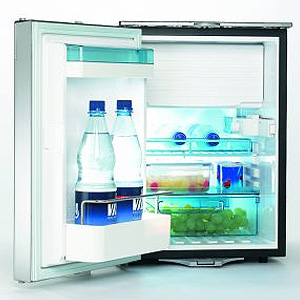 A lot of electricity is required to keep food cool in your home. The home refrigerator has ready access to power, but a Recreational Vehicle (RV) obviously doesn’t. There’s no magical unlimited power source in your RV, just batteries and road-generated energy. Carefully allocated, that mobile power is split between numerous systems, so how do RV refrigerators work if they can’t get the lion’s share of the electrical power supply?
A lot of electricity is required to keep food cool in your home. The home refrigerator has ready access to power, but a Recreational Vehicle (RV) obviously doesn’t. There’s no magical unlimited power source in your RV, just batteries and road-generated energy. Carefully allocated, that mobile power is split between numerous systems, so how do RV refrigerators work if they can’t get the lion’s share of the electrical power supply?
Employing an Alternative Cooling Principle
The compressor in a traditional domestic refrigerator is an energy glutton, so it’s not a workable solution inside a system that’s on a power budget. Instead, the cooling appliance operates via what at first seems like a counterintuitive absorption process. In brief, heat is used to produce cooling action. Undoubtedly, that notion doesn’t get in your mind, doesn’t feel right, so how does an RV refrigerator cool when heat is applied?
Mobile Cooling Principles
Bereft of a compressor, the cooling cycle uses a clever heat absorption refrigeration system to make a traditionally energy heavy process work while you’re on the road. In a way, the cycle is inverted. Compression technology is cast aside, gaseous evaporation is incorporated, and energy savings are realised. In order to begin the process, the heat source we mentioned earlier converts a liquid ammonia mix into a gas. Hydrogen and water, anti-corrosive-agents and ammonia, all of these chemical components facilitate evaporative action. Gravity and fluid dynamics partner now to pass the gas through tubes and hoses. It condenses, evaporates again, and heat is drawn from the surroundings until the refrigerator is properly cooled.
Assessing The Practicalities of RV Refrigeration
Standard RV refrigerators use an automatic controller, a setting that switches between a 110V power supply and an LP (Liquid Petroleum) gas reserve. The electricity and gas both heat the ammonia/water mix. Electrically, a simple heating element boils the liquid. Conversely, an LP gas flame replaces the heating element when mains power is unavailable. Then, when the recreational vehicle parks on its vacation spot, a hookup snaps in place and the electric heating element reenables the absorption refrigeration mechanism. As for any of the additionally generated heat, that’s vented out through the cabin ceiling.
RV refrigerators work off of a seemingly counterintuitive heating system. That system kicks off the cooling cycle by evaporating an ammonia/water blend. Once flowing through tubes, hoses, and an air-cooled condenser coil, the state changing refrigerant absorbs heat. The cooled environment inside the refrigerator operates when two heat sources are activated, so LP gas or 110V of heat-centric electricity will ensure your vacation food stays fresh and delicious.
